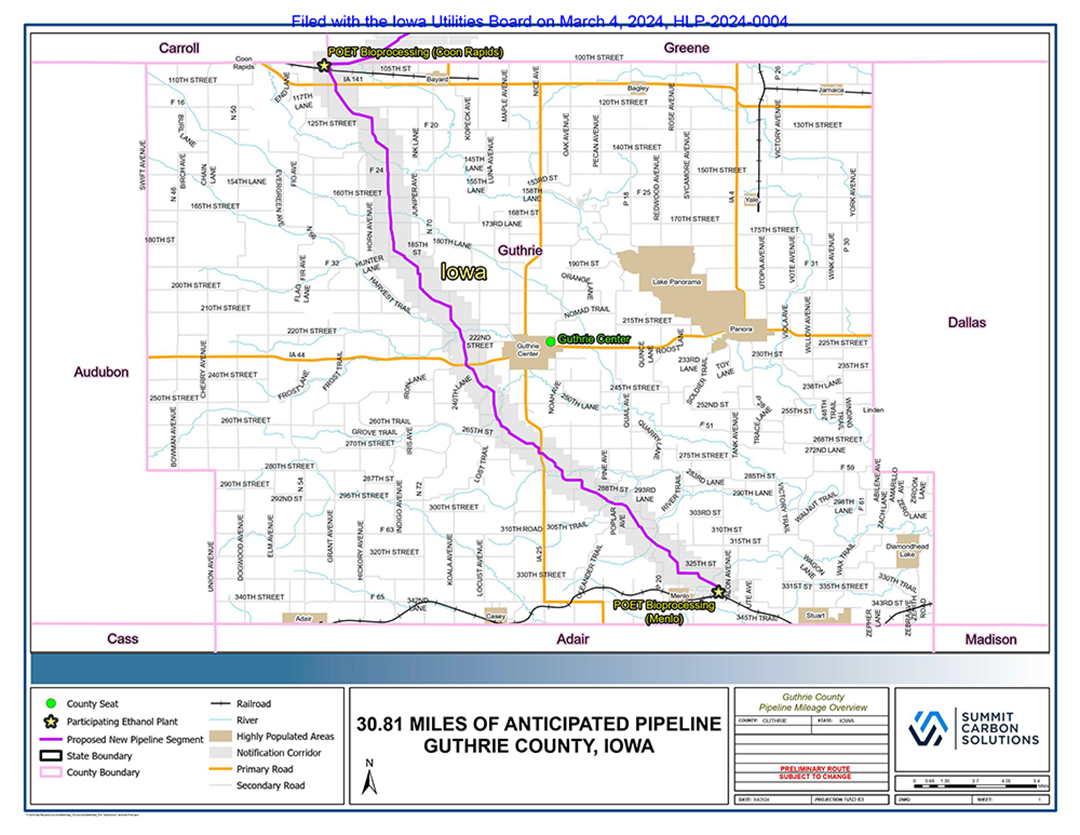
Map of the general corridor of planned CO2 pipeline from Coon Rapids to Menlo.
By Rich Wicks | Times Vedette
The proposed pipeline that Summit Carbon Solutions plans to build to transport carbon dioxide for storage in North Dakota is a hot topic in Guthrie County and in many parts of Iowa and the Midwest. The issue is complex, but this article aims to explain the basic facts and status.
What is CO2?
Carbon dioxide (CO2) is a gas that occurs naturally in the earth and in the atmosphere. Some of the CO2 in our atmosphere comes from the respiration of animals and humans, and some comes from combustion of fossil fuels (coal, natural gas, gasoline, etc.) in vehicles, factories and homes. CO2 has been identified as one of the “greenhouse gases” that contributes to global warming.
Plants take in CO2 and give off oxygen. The atmosphere contains about 78% nitrogen, 21% oxygen, .9% argon, and the remaining .1% is composed of other gases, including water vapor, methane and CO2.
Why Iowa?
Iowa leads the USA in corn production, and some of that corn is used to produce ethanol, which is used as a fuel. The production of ethanol creates CO2, and federal guidelines provide strong financial incentives for companies to meet certain “carbon footprint” benchmarks. One way this can be accomplished is through “carbon capture and sequestration.” This term describes the process of collecting and transporting CO2 via an underground pipeline to a storage facility. In this case, the planned storage would be deep underground in North Dakota. The planned project would include carbon capture from five states (Iowa, Nebraska, Minnesota, South Dakota and North Dakota).
The overall planned project includes 2,500 miles of underground pipeline from more than 50 ethanol plants with an estimated cost of $5.5 billion. In Guthrie County, an exact pipeline route has not yet been determined, but the state has approved a “corridor” inside which the final route is to be. Landowners within the corridor have received letters from Summit Carbon Solutions to begin the process of deciding on the pipeline route. The route corridor runs from the POET Biorefining plant in Coon Rapids to the POET Biorefining plant in Menlo.
What are the concerns?
Strong opinions and emotions have arisen regarding the project with opponents focusing mainly on the concerns of eminent domain and safety. Summit and other proponents of the project state that it will create jobs and help the local economy by allowing Iowa to greatly increase participation in the aviation fuel market.
The term “eminent domain” refers to a legal process through which the government has the power to take or use private property for public benefit, as long as the owners are appropriately paid. The Iowa Utilities Commission (formerly the Iowa Utilities Board) has the power to grant eminent domain for uses such as power lines and underground pipelines.
One of the central disputes regarding the currently planned CO2 pipeline is whether or not the pipeline meets the criteria of “public benefit.”
In Iowa, as in most states, such eminent domain decisions are made on a statewide basis rather than allowing each county to individually grant or deny access.
The safety concerns center on the dangers of a pipeline leak or breakage, which could release large amounts of CO2. Because the CO2 has to be compressed in order to be transported via a pipeline, it becomes denser and “flows” like a liquid until it expands and returns to its fully gaseous state. In case of a release of CO2, it could flow downhill and collect in low-lying areas where it could present a lethal danger to humans and animals.
Opponents of the project state that leakage and/or breakage are to be expected and have concerns that such leaks would result in catastrophic consequences. Proponents state that leaks and breaks are unlikely, and that pipelines have monitoring devices to alert staff to any leaks. They also state that the pipeline route would be designed to minimize risks. Proponents also stress that while CO2 can be fatal to humans and animals, any compressed CO2 would likely dissipate quickly in most weather conditions.
Many local landowners in Guthrie County have stated their opposition to the situation. Some feel their rights are being stripped, since they may end up with no choice regarding the pipeline if eminent domain power is used. Summit Carbon Solutions states that they will make every effort to reach easement agreements with all applicable landowners, using eminent domain as a last resort. Because of the legal and other complexities, if the project continues to move forward, pipeline construction would likely be more than a year in the future.
How can I learn more?
On Monday, Aug. 26 at 6 p.m., the public is invited to attend an informational meeting about eminent domain as it relates to the Summit CO2 project. The speaker will be former U.S. congressman Steve King. The meeting will be held at Guthrie Center Christian Church, 105 North Fourth St.
Another informational meeting regarding the project will also be open to the public. This meeting will be on Tuesday, Aug. 27, beginning at 6 p.m. at the Guthrie Center Activity Center, 207 State St.
